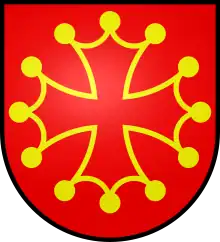Cleché
In heraldry, a cross (or other ordinary) cleché (clechée, clechy) flares out at the ends before tapering back to a point, in a shape resembling the bow of an old-fashioned key (French clé).[1][2] An example is the Occitan cross or Cross of Toulouse in the coat of arms of the counts of Toulouse: Gules, a cross cléchée, pommetty and voided Or. Because this Occitan cross is also voided (hollow), some writers[3] have mistakenly taken the term cléché to be a synonym of voided or to include voiding as a defining feature.[2]


See also
- Cercelée, a similarly re-interpreted cross (originally similar to a cross moline)
References
![]() This article incorporates text from a publication now in the public domain: Chambers, Ephraim, ed. (1728). "Cleché". Cyclopædia, or an Universal Dictionary of Arts and Sciences. Vol. Clausum–Coining (1st ed.). James and John Knapton, et al. p. 233.
This article incorporates text from a publication now in the public domain: Chambers, Ephraim, ed. (1728). "Cleché". Cyclopædia, or an Universal Dictionary of Arts and Sciences. Vol. Clausum–Coining (1st ed.). James and John Knapton, et al. p. 233.
- J. B. Rietstap, Armorial General, glossary s.v. croix cléchée (p. xix): "Se dit des arrondissements de la croix de Toulouse, dont les quatre extrémités sont faites comme les anneaux des clés."
- James Parker, A Glossary of Terms Used in Heraldry (James Parker & Co., 1894, reprinted David & Charles, 1970), in the entry on "Cross", pages 161–2
- E.g. Pimbley's Dictionary of Heraldry
